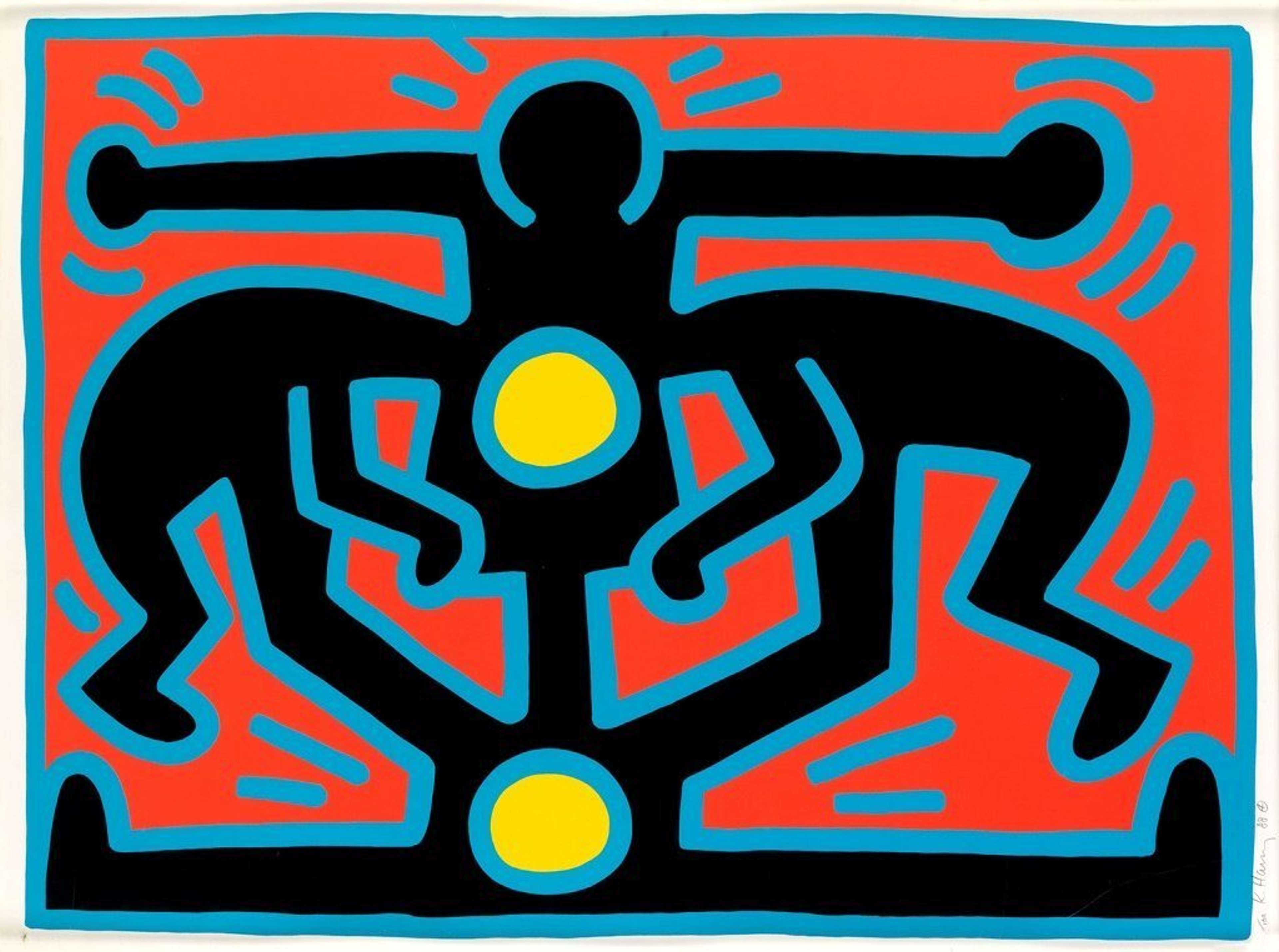 Growing 2 © Keith Haring 1988
Growing 2 © Keith Haring 1988
Interested in buying or selling
Keith Haring?

Keith Haring
249 works
Created after his diagnosis with HIV, Keith Haring's Growing series pronounces the importance of unity and togetherness in a world of division. The series is distinctively optimistic, alluding to Haring's hopes for a world of socio-political harmony.
The series features Haring's iconic 'People Ladder'.
 Growing 1 © Keith Haring 1988
Growing 1 © Keith Haring 1988Themes of unity, demoncracy, and optimism underscore Haring's oeuvre. In the first print in the series, Haring reimagined one of his so-called 'People Ladders', a tower of dancing figures reaching towards the top of the composition. This is a hopeful motif Haring explored on a much larger scale two years previously, with his monumental mural on the Berlin Wall.
The title of the series alludes to Haring's hopes for a world without division.
 Growing 5 © Keith Haring 1988
Growing 5 © Keith Haring 1988Within all of the prints in his Growing series, Haring represented his typical outlined figures morphing into one another. The interconnectedness of these figures alludes to unity, and removes any distinctions between sex, gender, race, or class.
The series is testament to Haring's democratic approach to art.
 Growing 3 © Keith Haring 1988
Growing 3 © Keith Haring 1988From his early graffiti and Subway Drawings, Haring always strove towards making art that was as accessible as possible. Projects like his Pop Shop were designed to bring art to a wider audience, while the subject of his work was always designed with universal legibility in mind. In the case of his Growing series, Haring's intertwined figures literally grow together, attesting to his rejection of capitalist individuality.
Growing champions joyousness, togetherness, and unity.
 Growing 1 (First State) © Keith Haring 1988
Growing 1 (First State) © Keith Haring 1988With his signature use of dots and dashes, Haring animated the figures that populate his Growing series with a joyful carelessness. As in Growing 1 (First State), many of the figures in the series appear to gleefully dance on one another's shoulders. In their sprawling state, the figures appear unified and reach towards new heights together, speaking to Haring's optimism for an undivided future.
The style of the series is reminiscent of Australian Aboriginal art.
 Growing 2 © Keith Haring 1988
Growing 2 © Keith Haring 1988Throughout his artistic career, Haring expressed his interest in Australian Aboriginal art. Particularly in his Growing series, we see the influence of Aboriginal style in his focus on flat block colours and symmetrical figurative compositions. By referencing Aboriginal art, Haring also alludes to a community which champions togetherness, the salient message of the series.
The Growing series reveals the influence of Andy Warhol on Haring.
 Andy Mouse 2 © Keith Haring 1986
Andy Mouse 2 © Keith Haring 1986In his use of bold primary colours and the process of screen printing to produce this series, Growing displays the influence of Andy Warhol. The founding father of Pop Art, Warhol had developed his screen printing process since 1962, under the influence of mass media printing presses. As one of Warhol's successors in Pop, Haring began experimenting in screen printing himself, continuing the Warhol legacy after his death in 1987.
Haring used bold colour to suggest the ecstasy of togetherness.
 Pop Shop VI, Plate IV © Keith Haring 1989
Pop Shop VI, Plate IV © Keith Haring 1989Vibrant colour is something which defines the work of Keith Haring, and makes it so eye-catching and joyous. The use of bold colour to suggest the delights of unity is not exclusive to his Growing series. Throughout his entire oeuvre, Haring used colour to draw the viewer's immediate attention and convey important messages in a fun and accessible way.
The series is an optimistic portrayal of mankind's potential.
 Growing 4 © Keith Haring 1988
Growing 4 © Keith Haring 1988As with much of Haring's work, Growing is an encouraging display of mankind's virtues. In Growing 4, for example, Haring represents the focal figure at the centre of the composition like the trunk of a tree. From this central figure, other figures grow and flourish, suggesting the empowering effects of unity and togetherness.
The series supported togetherness and unity during a period of socio-political division.
 Free South Africa 3 © Keith Haring 1985
Free South Africa 3 © Keith Haring 1985Haring reached the height of his artistic career in the 1980s, and always committed his art to reflecting the socio-political issues of his time. This was a decade underscored by the HIV/AIDS epidemic, the Cold War, the crack cocaine epidemic, and apartheid in South Africa - to name a few global issues. Haring was a staunch proponent of unity and justice, and used his art as activism and an appeal to global peace.
The Growing series was executed after Haring's diagnosis with HIV.
 Silence Equals Death © Keith Haring 1989
Silence Equals Death © Keith Haring 1989Two years before his untimely death from AIDS in 1990, Haring was diagnosed with the disease targeting gay communities across the world. Though Haring had always used his art to campaign for social justice, this became an even more salient theme after his diagnosis. As his Growing series attests, Haring used his art to advocate unity and togetherness until his death.
